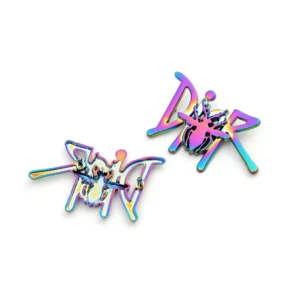The cost-effectiveness of creating custom metal labels depends on various factors, including the quantity, size, complexity of the design, and the specific method chosen.
Here are a few methods ranked from generally most cost-effective to least cost-effective:
Printed Metal Labels: Printing methods such as screen printing or digital printing tend to be more cost-effective for larger quantities or when intricate and colorful designs are required. This is because the setup costs for printing are relatively lower, and the process can be more efficient for mass production.
Engraved Metal Labels: Engraving is a versatile method that can be cost-effective for both small and large quantities. The setup costs for engraving are typically moderate, and the process is efficient for reproducing designs accurately. However, the cost may slightly increase for complex designs or smaller quantities due to the intricacy and setup time involved.
Embossed Metal Labels: Embossing can be cost-effective for medium to large quantities since the setup costs are relatively low. However, if the design requires intricate details or multiple levels of embossing, the cost may increase due to the complexity of the process.
Etched Metal Labels: Etching is often suitable for smaller quantities or when precise and intricate designs are needed. The cost-effectiveness of etching can vary depending on the complexity of the design and the size of the labels. For simple designs and larger quantities, other methods like printing or engraving may be more cost-effective.
Die-Cut Metal Labels: Die-cutting tends to be less cost-effective for small quantities due to the higher setup costs associated with creating custom cutting dies. However, for larger quantities or when unique label shapes are required, die-cutting can be a viable option.
It’s important to note that the cost-effectiveness of each method can vary depending on the specific project requirements, so it’s recommended to consult with manufacturers or suppliers who offer these services. They can provide you with more accurate cost estimates based on your specific needs and help you choose the most cost-effective method for your custom metal labels.
What are some factors to consider when determining the complexity of a design?
When determining the complexity of a design for custom metal labels, several factors should be considered.
Here are some key factors to keep in mind:
Level of Detail: The level of detail in the design refers to how intricate and fine the elements are. Designs with intricate patterns, small text, or intricate graphics will generally be more complex to produce compared to simpler designs with larger elements.
Number of Colors: If your design incorporates multiple colors, gradients, or shading, it will typically require more intricate printing or production processes, metal labels custom increasing the complexity and potentially the cost.
Size and Scale: The size of the design relative to the label’s dimensions can affect its complexity. Very small designs require a high level of precision during production, while larger designs may require additional considerations such as scaling and distortion.
Cutouts and Intricate Shapes: Designs that include cutouts or intricate shapes that need to be accurately reproduced on the metal label can add complexity. These designs may require additional steps, such as die-cutting or laser cutting, which can impact the production process.
Material Considerations: Different metal materials have varying properties and limitations. Some metals may be more challenging to work with for complex designs due to their hardness, thickness, or other characteristics. The design complexity should be assessed in conjunction with the chosen metal material.
Production Method: The chosen production method for creating the metal labels can also impact the complexity of the design. Some methods may be better suited for handling intricate designs, while others may have limitations in reproducing certain elements accurately.
Production Time and Cost: Highly complex designs may require more time and resources during the production process, leading to increased costs. Consider your budget and timeline constraints when evaluating the complexity of a design.
When working with a manufacturer or supplier for your custom metal labels, it’s advisable to share your design concept and discuss these factors with them. They can provide guidance on the feasibility and complexity of your design and help you make any necessary adjustments to achieve the desired outcome within your requirements.
